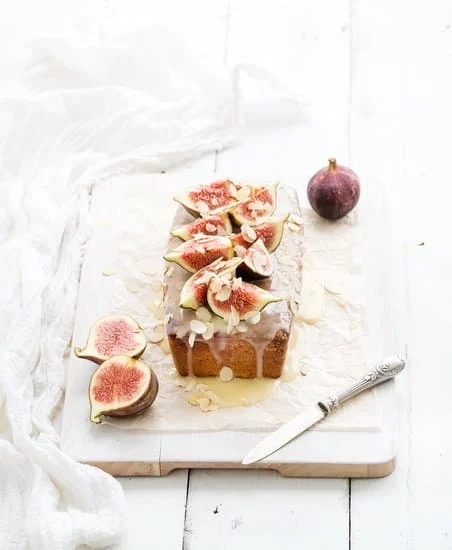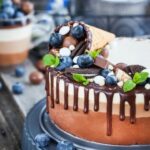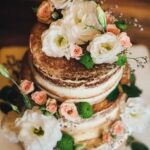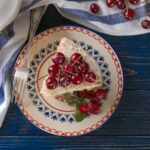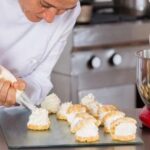Decorating a cake with buttercream is an essential skill for any aspiring baker or cake enthusiast. Buttercream not only adds flavor and moisture to a cake but also serves as the perfect medium for creating stunning designs and decorations. Whether you’re looking to create a simple, elegant design or an elaborate masterpiece, mastering the art of buttercream decoration is key.
Buttercream comes in various forms, such as Swiss, Italian, and American buttercream, each with its own unique characteristics that affect taste and texture. Understanding these differences is crucial in achieving the desired result when decorating a cake. From smooth finishes to intricate piping work, the type of buttercream used can make all the difference in the final presentation of your creation.
In this article, we will delve into the world of cake decorating with buttercream, exploring the various types of buttercream available and how to properly prepare them for decorating. Additionally, we will discuss essential tools and equipment needed for this creative process as well as offer valuable tips on different decorating techniques and troubleshooting common issues that may arise.
So grab your piping bags and spatulas – it’s time to unleash your inner pastry artist and elevate your cakes with buttercream beauty.
Types of Buttercream
Buttercream is a versatile frosting that plays a crucial role in cake decorating, providing both flavor and texture to your baked creations. When it comes to buttercream, there are different types that you can choose from, each with its own unique characteristics. The three main types of buttercream commonly used in cake decorating are Swiss, Italian, and American buttercream.
Swiss Buttercream
Swiss buttercream is known for its silky smooth texture and light, airy consistency. This type of buttercream is made by whisking egg whites and sugar over a double boiler until the mixture reaches a safe temperature, then whipping in softened butter until creamy. Swiss buttercream is less sweet compared to other types of buttercream and holds up well in warm temperatures, making it ideal for decorating cakes for special occasions.
Italian Buttercream
Italian buttercream is made by pouring a hot sugar syrup into whipped egg whites, creating a stable meringue base. Once the meringue has cooled down, softened butter is added gradually to create a smooth and luxurious frosting. With its rich taste and decadent texture, Italian buttercream is often favored for wedding cakes and intricate cake designs that require intricate piping work.
American Buttercream
American buttercream is perhaps the most popular type of buttercream due to its simplicity and sweetness. Made with just butter, powdered sugar, vanilla extract, and a pinch of salt, American buttercream is easy to prepare and has a rich and creamy consistency.
It’s perfect for beginners or when you need a quick frosting for cupcakes or sheet cakes. Although it may not be as stable as Swiss or Italian buttercream in warm weather conditions, American buttercream is loved for its sweet taste and ease of use when decorating cakes at home.
Understanding the different types of buttercreams available can help you choose the best one for your cake decorating needs based on flavor preferences, desired consistency, and decorating techniques. Whether you opt for the lightness of Swiss, the richness of Italian, or the simplicity of American buttercream, each type offers a delicious way to elevate your cake designs with a beautiful finish.
Tools and Equipment
Decorating a cake with buttercream can be a fun and creative process, but having the right tools and equipment is essential to achieve professional-looking results. Here are some of the necessary items you will need to have on hand before you start decorating:
Piping Bags
Piping bags are essential for applying buttercream to the cake in various designs and shapes. They come in different sizes and materials, such as disposable plastic or reusable cloth options.
Piping Tips
These metal tips are attached to the piping bags to create different patterns and textures when decorating your cake with buttercream. There are countless shapes and sizes available, each producing a unique design.
Offset Spatula
An offset spatula is useful for spreading buttercream evenly on the cake’s surface and for creating smooth finishes. Its angled shape allows for better control and precision while decorating.
Understanding how to use these tools correctly will ensure that your cake turns out beautifully decorated with buttercream. Experimenting with different piping techniques and designs can help unleash your creativity when it comes to customizing cakes for any occasion.
| Tools and Equipment | Description |
|---|---|
| Piping Bags | Essential for applying buttercream in various designs. |
| Piping Tips | Metal tips attached to piping bags for creating patterns. |
| Offset Spatula | Used for spreading buttercream on the cake’s surface. |
Preparation
Buttercream is a versatile frosting that plays a crucial role in cake decorating. Its smooth texture and ability to hold intricate designs make it a popular choice for both amateur bakers and professional pastry chefs. Before you can start decorating your cake with buttercream, it is essential to prepare the frosting properly to ensure the best results.
To begin, gather all the necessary ingredients for your buttercream recipe. This typically includes unsalted butter, powdered sugar, vanilla extract (or other flavorings), and a pinch of salt. Make sure your butter is at room temperature to achieve a creamy consistency when mixing it with the sugar.
Next, using an electric mixer or stand mixer, cream the butter until it is light and fluffy. Gradually add in the powdered sugar, making sure to mix well after each addition. This will ensure that your buttercream is smooth and free of any lumps. Finally, add in your desired flavorings and continue mixing until everything is well incorporated. Once you have achieved the perfect consistency, you are ready to decorate your cake with buttercream.
Cake Decorating Techniques
Piping
One of the most popular and versatile cake decorating techniques using buttercream is piping. Piping involves using a piping bag with different tips to create various designs on the cake’s surface. Common tips used for piping include round, star, leaf, and petal tips.
To pipe with buttercream, simply fill the piping bag with the desired buttercream consistency and start decorating the cake by squeezing out the buttercream through the tip. This technique allows for intricate designs such as rosettes, borders, flowers, and even writing.
Frosting
Frosting a cake with buttercream involves covering the entire surface of the cake evenly with a thick layer of buttercream. This technique can be achieved using an offset spatula or a bench scraper to smooth out the buttercream and create a clean finish. To frost a cake with buttercream, start by applying a crumb coat-a thin layer of buttercream that seals in any loose crumbs.
Then, apply a thicker layer of buttercream over the crumb coat and use the tool of your choice to smooth it out. Frosting gives cakes a polished look and serves as a base for additional decorations.
Smoothing
Achieving a smooth final finish on a cake decorated with buttercream is essential for professional-looking results. To smooth out buttercream on a cake, you can use different methods such as Viva paper towel technique or hot spatula method. The Viva paper towel technique involves gently pressing a clean paper towel against freshly frosted buttercream to remove any imperfections and create a smooth surface.
The hot spatula method entails dipping an offset spatula into hot water, wiping off excess water, and then smoothing out the buttercream by gently running the spatula over it. Experiment with these techniques to find which one works best for your desired outcome when decorating cakes with buttercream.
Color and Flavor Options
Color and flavor play a crucial role in making a cake not only visually appealing but also delicious. When it comes to decorating a cake with buttercream, there are endless possibilities for customization. One popular method is to create different shades of buttercream by adding food coloring.
Gel food coloring is preferred over liquid food coloring as it provides more vibrant colors without altering the consistency of the buttercream. Start with a small amount of color and gradually add more until you achieve the desired hue. Remember that colors may deepen over time, so allow the buttercream to sit for a few minutes before adjusting.
In addition to color, flavoring buttercream can take your cake to the next level. While traditional vanilla buttercream is always a crowd-pleaser, experimenting with different extracts such as almond, lemon, or coconut can elevate the taste of your creation. You can also incorporate pureed fruit, cocoa powder, or coffee granules for unique flavors. Keep in mind that some flavors may require adjustments to the sugar content or consistency of the buttercream, so be prepared to make modifications accordingly.
For those looking to add visual interest and texture to their buttercream decorations, consider using edible embellishments like sprinkles, edible glitter, or even crushed nuts. These elements not only enhance the overall look of the cake but also provide added depth and dimension.
Remember that when working with decorations on buttercream, it’s important to apply them while the frosting is still fresh so they adhere properly. With a little creativity and experimentation, you can truly make your cake stand out and impress your guests at any special occasion.
| Color Options | Flavor Options |
|---|---|
| Gel food coloring for vibrant shades | Experiment with extracts like almond or lemon |
| Create custom hues by mixing colors | Incorporate pureed fruit or cocoa powder |
| Add edible embellishments like sprinkles | Use coffee granules for a unique taste |
Troubleshooting
Decorating a cake with buttercream can be a rewarding experience, but it’s not without its challenges. When working with buttercream, there are common issues that may arise during the decorating process. Here are some tips on how to troubleshoot these problems and ensure a smooth cake decorating experience:
1. Crumbly Buttercream: If your buttercream is too dry and crumbly, it can make decorating a cake difficult. To fix this issue, try adding a small amount of liquid such as milk or cream to the buttercream and mix until you reach the desired consistency.
2. Air Bubbles: Sometimes air bubbles can get trapped in the buttercream while mixing or piping, resulting in an uneven finish on the cake. To prevent this issue, gently tap the filled piping bag on the counter before piping to release any trapped air bubbles.
3. Buttercream Melting: When working in a warm environment, buttercream can start to melt and lose its shape while decorating a cake. To avoid this problem, make sure to work in a cool room with proper ventilation or refrigerate the cake for short intervals between decorating steps.
By being aware of these common issues that may arise when decorating a cake with buttercream, you can troubleshoot and overcome them effectively. With patience and practice, you can achieve beautifully decorated cakes that will impress your friends and family at any special occasion.
Inspiration and Ideas
When it comes to decorating cakes with buttercream, the possibilities are endless. From simple designs to intricate creations, buttercream can be molded and shaped to bring any cake vision to life. Here are some inspirational ideas and designs that you can achieve using buttercream decoration techniques:
- Floral Fantasy: Create a stunning floral arrangement on your cake by piping delicate buttercream flowers in various colors. Use different piping tips to create roses, daisies, and other blooms for a beautiful and elegant design.
- Ombre Elegance: Achieve a modern and sophisticated look by incorporating an ombre effect into your buttercream design. Gradually blend different shades of the same color from dark to light for a seamless and stylish finish.
- Geometric Glamour: Add a touch of contemporary flair to your cake with geometric patterns created using buttercream. Use a piping bag fitted with a small round tip to pipe squares, triangles, or hexagons onto the cake for a trendy and unique design.
Experiment with combining these different techniques to create a truly personalized cake that reflects your style and creativity. Whether you’re celebrating a birthday, wedding, or any special occasion, decorating a cake with buttercream allows you to showcase your artistic talents and impress your guests with a delicious treat that looks as good as it tastes.
Remember, practice makes perfect when it comes to mastering buttercream decoration techniques. Don’t be afraid to get creative and try out new ideas – the more you experiment with different designs, the more confident you’ll become in decorating cakes with buttercream. So grab your tools, whip up some buttercream, and let your imagination run wild as you bring your cake decorating visions to life.
Conclusion
In conclusion, decorating a cake with buttercream offers a versatile and delicious option for creating beautiful and unique designs. By exploring the different types of buttercream such as Swiss, Italian, and American, individuals can choose the one that best suits their preferences and needs. Additionally, having the right tools and equipment is essential in achieving professional-looking results when decorating with buttercream.
Preparation is key when it comes to working with buttercream, and following a step-by-step guide can help ensure smooth and successful decorating process. From piping intricate designs to frosting cakes with finesse and smoothing out imperfections, there are various techniques that individuals can practice to elevate their cake decorating skills. Furthermore, experimenting with different colors and flavors can add a personalized touch to any cake design.
Aspiring bakers and decorators are encouraged to try their hand at decorating a cake with buttercream by applying the tips and techniques mentioned in this article. With practice and creativity, anyone can create stunning cake designs that are sure to impress both visually and in taste. So go ahead, gather your tools, prepare your buttercream, unleash your imagination, and let your creativity shine as you decorate your next cake with buttercream.
Frequently Asked Questions
Do You Decorate Cakes With Buttercream?
I love decorating cakes with buttercream because of its smooth texture and versatility. It allows me to create beautiful designs, from simple swirls to intricate flowers. Plus, buttercream tastes delicious and adds a creamy richness to any cake.
How Do You Top a Cake With Buttercream?
When topping a cake with buttercream, I usually start by applying a thin layer called a crumb coat to seal in any loose crumbs. Then, I add a thicker layer of buttercream using an offset spatula or piping bag, depending on the design I want to achieve. Finally, I smooth out the buttercream for a clean finish.
What Is the Best Buttercream for Covering a Cake?
In my experience, Swiss meringue buttercream is the best option for covering a cake. It has a silky texture and is less sweet than other types of buttercream, making it perfect for those who prefer a more subtle sweetness.
Additionally, Swiss meringue buttercream is stable and holds up well in different climates, making it ideal for covering cakes that need to sit out for longer periods of time.

Welcome to our cake decorating blog! My name is Destiny Flores, and I am the proud owner of a cake decorating business named Cake Karma. Our mission is to provide delicious, beautiful cakes for all occasions. We specialize in creating custom cakes that are tailored specifically to each customer’s individual needs and tastes.

